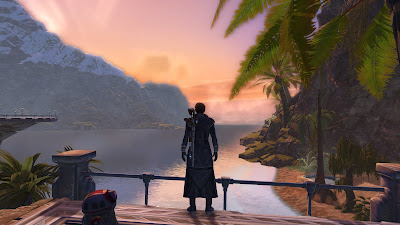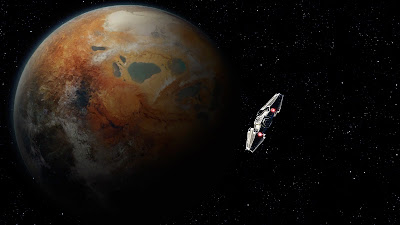This is part two of a post I put up yesterday. I orginally put up both parts at once, but after sleeping on it I decided to break it up. Even for my blog , where my readers must be unusually patient with long-form rambling, it was a likely a very TLDR inducing post :-)
Having set the stage, I can now move into the idea that motivated this garrulous post duology. I speculate that MMORPGs were the first games to occupy the shared digital world product niche, and by getting there first they perhaps had more success than they really could maintain. We can think about an analogous process in organic evolution, where there are all sorts of ecological niches that will get filled by some organism given enough evolutionary time and opportunity. When we look in the geological record of various time periods, or sometimes in different regions during a given era, we see different groups filling those roles. Often the later species to fill a given niche are more complex organisms that members of earlier lineages that filled the same role would have trouble competing with.
For example, one niche that is particularly dramatic and easy to think about is the "top predator" niche. In any given ecosystem there are usually a few species near the very top of food webs, that as adults can prey upon any other species they come across and are themselves almost immune to predation. Think of a lion in modern African ecosystems, a tiger in Asian ones, or a polar bear in the arctic. In marine environments the progression of top predators over geological time was especially dramatic. The first marine top predators were various types of invertebrates, culminating in the Pterygotids. This groups includes the largest arthropods ever known to have existed, and were almost certainly among the top predators of their environments. However, a basic arthropod design has some serious disadvantages when it comes to being a truly large animal. Among the primary issues is that the skeleton is on the outside of the muscles. That means that the size and weight of the skeletal elements increases faster than the power of the muscles that move them around as you keep scaling up in overall body size. So the largest sea scorpions were probably large as animal using that basic bauplan can get and still function well, at least here on earth.
Vertebrates had also been trucking along for a while at that point, but until the Devonian period they didn't get particularly big. However, they had one huge advantage. By having a basic design where you put the supporting skeleton on the inside and the muscles that power it on the outside, they are able to achieve much larger functional body sizes than any arthropod could ever hope to. Being really big is also pretty important for a top predator, as they need to be able to overpower anything they want to eat. In the Devonian, around 385 million years ago, we see the first big aquatic vertebrates filling the top predator niche in their local ecosystems. From there we see a progression of a variety of top predators coming from different vertebrate taxonomic groups, culminating in two absolutely monstrous animals that lived in the same time and place and may never be equaled again. Though to be fair even the relatively paltry orcas and great white sharks of today are still very impressive animals that would have killed a sea scorpion (the top image) with ease.
 |
| The first really impressive vertebrate predators we find in the fossil record are these arthrodires that lived from around 380 to 360 million years ago, in the Devonian. They belong to an early group of jawed fish that are now completely extinct. From here to the present we see an ever more impressive array of top marine predators in the fossil record, each more terrifying looking than the last. Once big vertebrates were on the scene, the age of arthropod top predators was over. Vertebrates could reach body sizes that no arthropod could hope to equal, and with that came corresponding speed and bite force. |
Going back to the evolution of shared virtual spaces, I am now beginning to think of MMORPGs as an early experiment that succeeded despite the technological limitations of the time by stealing crunchy mechanics from other games. These mechanics helped to create the illusion of a world, and allowed them to succeed despite primitive graphics and a first hour experience full of absolute confusion for many players. These days any visuals or interactions that you care to represent are possible to render digitally. Instead of creating the illusion of a world with mechanical depth, games can create the illusion of a world by simply rendering it in nearly photorealistic detail and putting a lot of stuff to interact with in it. That is actually a much better mass market solution than crunchy RPG mechanics. For example, most people have no interest whatsoever in understanding something as arcane as how stats really work in Everquest, or how you build out a legendary item in LoTRO. But do they want to run around in an extremely well realized shared digital world and have all kinds of adventures? Hell yes, almost everyone can see how that is fun.
 |
| This terrifying animal, Livyatan, was larger than a modern sperm whale. From the arthrodires (above) we see a gradual, but certainly not linear, progression of vertebrate marine top predators. Giant lobe finned fish, Ichthyosaurs, Pliosaurs, Mososaurs, even a 40 foot long marine snake. All of this culminated in the two largest macro-raptorial animals that ever lived (unless Ichthyotitan was actually predatory and not a planktivore). Megaladon, a giant shark that only seems to have died out about 3.6 million years ago, you have almost certainly heard of. Livyatan overlapped with it in space and time. Unlike modern sperm whales that basically slurp up giant squid like they are big scary noodles, this species was an active predator going after prey much closer in size to its own. It was up to 60 feet long and absolutely used those teeth to take giant bites out of other whales. Both this species and Megaladon lived in an oddball ecosystem where there were tons of baleen whales about the size of a gray whale. In this environments both sharks and hypercarnivorous whales evolved to be the tigers to these planktivorous whale antelope. |
I also suspect that is why we have started to see more and more games that aren't MMORPGs begin to incorporate MMO elements, and in turn why the market for MMORPGs has stagnated. Other types of games have started to take over that market niche. What we are seeing now is the inevitable transition from arthropod top predators to vertebrate top predators that can engage a wider variety of players and do so much faster.* Once you can digitally represent anything you can think of, distracting players with crunchy mechanics and endless statistical complexity becomes completely unnecessary. And much like how the endoskeletons of vertebrates are a superior basis for top predator compared to the exoskeletons of arthropods, design elements that generate player immersion almost as soon as you stick your head into a space are a much better starting point for mass market shared digital worlds than crunchy RPG mechanics that a casual "five-minute impression" player (1) may not notice or (2) may even be turned off by if they do.
 |
| Like a vertebrate, cephalopods have a "muscles on the outside" design (in their case the arms consist of a solid bands of muscle surrounding a central nerve cord) and can get very large. Much larger than any arthropod. In fact, cephalopods have kind of always been waiting in the wings, and would likely be quite happy to take over the top predator role if vertebrates ever really stumble.** Will invertebrates retake the marine top predator crown at some point in the future? While that would no doubt be a fascinating development, and I'd love to see what kind of designs they would come up with (if I were immortal and could watch the whole thing play out) I have to admit I doubt it. Fish are so abundant and diverse that even if all the current big ones (along with marine mammals) got wiped out, some other fish would probably take over in a half million years or so. In a similar vein, I'm not betting my retirement on a major western MMORPG revival any time soon, as much as it would delight me. |
Now I love me some crunchy RPG mechanics, don't get me wrong. I am honestly a bit sad to see games like LoTRO, SWTOR, and many similar ones that I love (and started this blog largely to talk about) start to fade from the limelight. But I won't be too upset! A ton of innovation is happening in the space of shared digital environments right now, and quite frankly I can't wait to see what comes next.
That said, every time a new MMORPG comes out I will be rooting for it. "You go little sea scorpion, show them what you can do!"


























